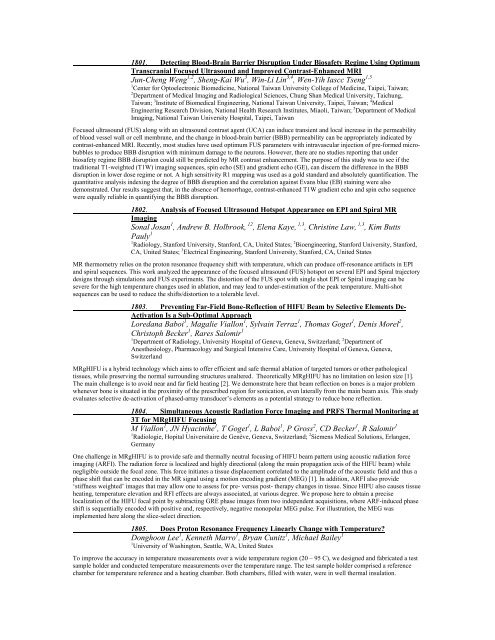Traditional Posters: Interventional - ismrm
Traditional Posters: Interventional - ismrm
Traditional Posters: Interventional - ismrm
Create successful ePaper yourself
Turn your PDF publications into a flip-book with our unique Google optimized e-Paper software.
1801. Detecting Blood-Brain Barrier Disruption Under Biosafety Regime Using Optimum<br />
Transcranial Focused Ultrasound and Improved Contrast-Enhanced MRI<br />
Jun-Cheng Weng 1,2 , Sheng-Kai Wu 3 , Win-Li Lin 3,4 , Wen-Yih Iascc Tseng 1,5<br />
1 Center for Optoelectronic Biomedicine, National Taiwan University College of Medicine, Taipei, Taiwan;<br />
2 Department of Medical Imaging and Radiological Sciences, Chung Shan Medical University, Taichung,<br />
Taiwan; 3 Institute of Biomedical Engineering, National Taiwan University, Taipei, Taiwan; 4 Medical<br />
Engineering Research Division, National Health Research Institutes, Miaoli, Taiwan; 5 Department of Medical<br />
Imaging, National Taiwan University Hospital, Taipei, Taiwan<br />
Focused ultrasound (FUS) along with an ultrasound contrast agent (UCA) can induce transient and local increase in the permeability<br />
of blood vessel wall or cell membrane, and the change in blood-brain barrier (BBB) permeability can be appropriately indicated by<br />
contrast-enhanced MRI. Recently, most studies have used optimum FUS parameters with intravascular injection of pre-formed microbubbles<br />
to produce BBB disruption with minimum damage to the neurons. However, there are no studies reporting that under<br />
biosafety regime BBB disruption could still be predicted by MR contrast enhancement. The purpose of this study was to see if the<br />
traditional T1-weighted (T1W) imaging sequences, spin echo (SE) and gradient echo (GE), can discern the difference in the BBB<br />
disruption in lower dose regime or not. A high sensitivity R1 mapping was used as a gold standard and absolutely quantification. The<br />
quantitative analysis indexing the degree of BBB disruption and the correlation against Evans blue (EB) staining were also<br />
demonstrated. Our results suggest that, in the absence of hemorrhage, contrast-enhanced T1W gradient echo and spin echo sequence<br />
were equally reliable in quantifying the BBB disruption.<br />
1802. Analysis of Focused Ultrasound Hotspot Appearance on EPI and Spiral MR<br />
Imaging<br />
Sonal Josan 1 , Andrew B. Holbrook, 12 , Elena Kaye, 1,3 , Christine Law, 1,3 , Kim Butts<br />
Pauly 1<br />
1 Radiology, Stanford University, Stanford, CA, United States; 2 Bioengineering, Stanford University, Stanford,<br />
CA, United States; 3 Electrical Engineering, Stanford University, Stanford, CA, United States<br />
MR thermometry relies on the proton resonance frequency shift with temperature, which can produce off-resonance artifacts in EPI<br />
and spiral sequences. This work analyzed the appearance of the focused ultrasound (FUS) hotspot on several EPI and Spiral trajectory<br />
designs through simulations and FUS experiments. The distortion of the FUS spot with single shot EPI or Spiral imaging can be<br />
severe for the high temperature changes used in ablation, and may lead to under-estimation of the peak temperature. Multi-shot<br />
sequences can be used to reduce the shifts/distortion to a tolerable level.<br />
1803. Preventing Far-Field Bone-Reflection of HIFU Beam by Selective Elements De-<br />
Activation Is a Sub-Optimal Approach<br />
Loredana Baboi 1 , Magalie Viallon 1 , Sylvain Terraz 1 , Thomas Goget 1 , Denis Morel 2 ,<br />
Christoph Becker 1 , Rares Salomir 1<br />
1 Department of Radiology, University Hospital of Geneva, Geneva, Switzerland; 2 Department of<br />
Anesthesiology, Pharmacology and Surgical Intensive Care, University Hospital of Geneva, Geneva,<br />
Switzerland<br />
MRgHIFU is a hybrid technology which aims to offer efficient and safe thermal ablation of targeted tumors or other pathological<br />
tissues, while preserving the normal surrounding structures unaltered. Theoretically MRgHIFU has no limitation on lesion size [1].<br />
The main challenge is to avoid near and far field heating [2]. We demonstrate here that beam reflection on bones is a major problem<br />
whenever bone is situated in the proximity of the prescribed region for sonication, even laterally from the main beam axis. This study<br />
evaluates selective de-activation of phased-array transducer’s elements as a potential strategy to reduce bone reflection.<br />
1804. Simultaneous Acoustic Radiation Force Imaging and PRFS Thermal Monitoring at<br />
3T for MRgHIFU Focusing<br />
M Viallon 1 , JN Hyacinthe 1 , T Goget 1 , L Baboi 1 , P Gross 2 , CD Becker 1 , R Salomir 1<br />
1 Radiologie, Hopital Universitaire de Genève, Geneva, Switzerland; 2 Siemens Medical Solutions, Erlangen,<br />
Germany<br />
One challenge in MRgHIFU is to provide safe and thermally neutral focusing of HIFU beam pattern using acoustic radiation force<br />
imaging (ARFI). The radiation force is localized and highly directional (along the main propagation axis of the HIFU beam) while<br />
negligible outside the focal zone. This force initiates a tissue displacement correlated to the amplitude of the acoustic field and thus a<br />
phase shift that can be encoded in the MR signal using a motion encoding gradient (MEG) [1]. In addition, ARFI also provide<br />
‘stiffness weighted’ images that may allow one to assess for pre- versus post- therapy changes in tissue. Since HIFU also causes tissue<br />
heating, temperature elevation and RFI effects are always associated, at various degree. We propose here to obtain a precise<br />
localization of the HIFU focal point by subtracting GRE phase images from two independent acquisitions, where ARF-induced phase<br />
shift is sequentially encoded with positive and, respectively, negative monopolar MEG pulse. For illustration, the MEG was<br />
implemented here along the slice-select direction.<br />
1805. Does Proton Resonance Frequency Linearly Change with Temperature?<br />
Donghoon Lee 1 , Kenneth Marro 1 , Bryan Cunitz 1 , Michael Bailey 1<br />
1 University of Washington, Seattle, WA, United States<br />
To improve the accuracy in temperature measurements over a wide temperature region (20 – 95 C), we designed and fabricated a test<br />
sample holder and conducted temperature measurements over the temperature range. The test sample holder comprised a reference<br />
chamber for temperature reference and a heating chamber. Both chambers, filled with water, were in well thermal insulation.















